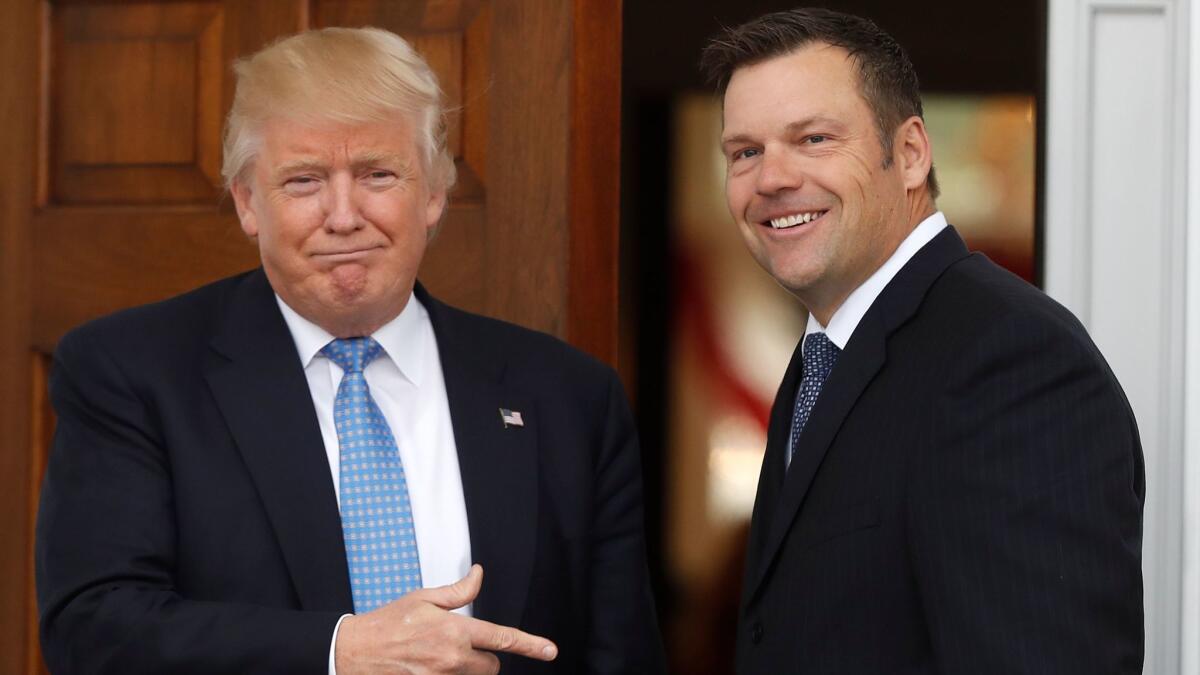Op-Ed: Why immigrants won’t self-deport

Self-deportation is back in vogue. President-elect Donald Trump’s chief immigration advisor, Kris Kobach, told Fox News: “The jobs are going to dry up, the welfare benefits are going to dry up, and a lot of people who may not be criminal aliens may decide, hey, it’s getting hard to disobey federal law, and may leave on their own.”
Mass self-deportation has been a staple of the anti-immigration movement for more than a decade. Mitt Romney adopted it as his main immigration policy prescription in 2012. Sometimes called the “attrition through enforcement” or “immiseration” approach to immigration control, the logic is to make life so difficult for immigrants to find work that they give up and go home.
In 2014, the probability that one of the nation’s 6 million employers would be investigated for violating immigration laws was 0.03%.
Pushing self-deportation is a tacit acknowledgement that carrying out aggressive sweeps to remove millions of immigrants who entered the country illegally is not politically realistic. According to election day exit polls, 70% of voters believe that such immigrants working in the United States should be offered a path to legal status. Even 34% of Trump voters rejected mass deportations.
But the self-deportation option is not terribly realistic either.
The last time large numbers of Mexicans in the U.S. repatriated themselves was during the Great Depression. Between 1929 and 1936, at least 500,000 Mexican workers — by some estimates as many as 2 million — returned to their homeland. Although some were forced out by federal and local authorities, the majority returned to Mexico of their own accord, paying their own way back. The Depression had wiped out their jobs, and scapegoating of immigrants by the Hoover administration had created a hostile environment.
Short of another depression, what would it take to spur another self-deportation wave? Two-thirds of immigrants in the country illegally have lived here for 10 years or more. Removing their access to welfare, as Kobach suggests, won’t do the trick — they are already barred from receiving such benefits. Such workers would have to become truly unemployable, not just in some businesses and communities, but in all of them, everywhere.
To achieve that goal, the federal government would have to systematically and aggressively go after employers who hire workers in the U.S. illegally. But enforcement of immigration law in the workplace has remained at a symbolic level since 1986, when Congress first made it illegal to hire such workers. From 2007 to 2014, the number of employers investigated for violating hiring laws for immigrants averaged fewer than 2,500 per year, nationwide. The vast majority were not prosecuted criminally but simply fined.
The reasons for weak workplace enforcement are widely recognized. For starters, Congress deliberately included a gaping loophole in the Immigration Reform and Control Act, making it extremely difficult to prosecute employers that break the law. The loophole has remained since 1986 because it is politically advantageous.
There has never been much public or congressional appetite for a harsh crackdown on employers, especially the small businesses that depend most heavily on workers in the U.S. illegally. They are pillars of their communities and campaign contributors. Besides, immigration agents have had higher enforcement priorities — tracking down immigrants who committed serious crimes or pose national security threats.
President-elect Trump has called for full implementation of an electronic employment eligibility verification system called E-Verify. Established as a pilot program by immigration authorities in 1996, E-Verify crosschecks basic information provided by job applicants with federal databases. Employer participation is voluntary, and only about 8% of businesses are enrolled. Trump has promised to make participation mandatory.
E-Verify, however, is no panacea. It does not prevent immigrants who are ineligible to work from getting jobs by providing valid information pertaining to other people (borrowed documents). And as long as penalties are weak, requiring employers to use E-Verify will not significantly reduce violations.
Will Congress approve crippling fines or even prison sentences for business owners who ignore E-Verify rules? Will lawmakers direct the Justice Department to make these scofflaws a top priority? Unless and until that happens, many employers will continue to view hiring those in the U.S. illegally as a low-risk, high-reward crime. In 2014, the probability that one of the nation’s 6 million employers would be investigated for violating immigration laws was 0.03%.
When my research team asked hundreds of immigrants working illegally in California how they obtained their most recent U.S. job, more than three out of five reported that their employer probably knew, or knew for sure, that they were not authorized to work in the United States. Absent a significant increase in worksite investigations and criminal prosecutions, such employers will not change their hiring practices.
Mass self-deportation is destined to remain a fantasy of immigration hawks. Turning the U.S. into a police state to get rid of a large chunk of the labor force that most citizens consider indispensable is not politically sustainable, let alone economically sensible.
Wayne A. Cornelius is director emeritus of the Mexican Migration Field Research Program and Distinguished Professor of Political Science at the UC San Diego.
Follow the Opinion section on Twitter @latimesopinion and Facebook
More to Read
A cure for the common opinion
Get thought-provoking perspectives with our weekly newsletter.
You may occasionally receive promotional content from the Los Angeles Times.










